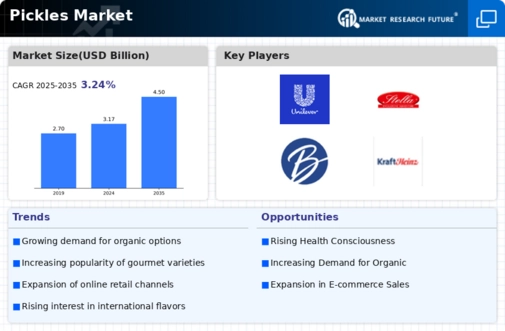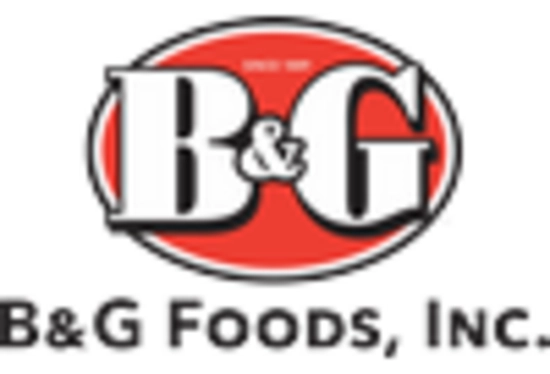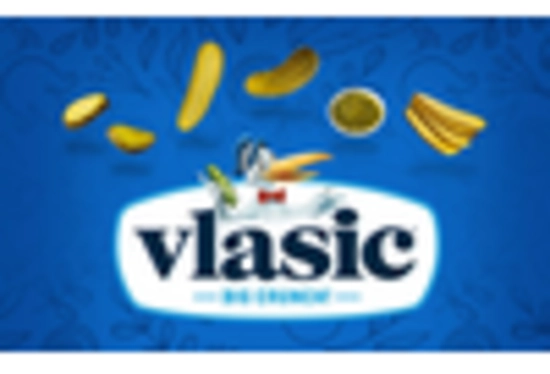Cucumber Pickles
Mixed Pickles
Olive Pickles
Chili Pickles
Other Pickles
Glass Jars
Plastic Bottles
Metal Cans
Pouches
Bulk Packaging
Supermarkets
Online Retail
Convenience Stores
Specialty Stores
Wholesale
Household
Food Service
Food Processing
North America
Europe
South America
Asia Pacific
Middle East and Africa
North America Outlook (USD Billion, 2019-2035)
North America Pickles Market by Product Type
Cucumber Pickles
Mixed Pickles
Olive Pickles
Chili Pickles
Other Pickles
North America Pickles Market by Packaging Type
Glass Jars
Plastic Bottles
Metal Cans
Pouches
Bulk Packaging
North America Pickles Market by Distribution Channel Type
Supermarkets
Online Retail
Convenience Stores
Specialty Stores
Wholesale
North America Pickles Market by End Use Type
Household
Food Service
Food Processing
North America Pickles Market by Regional Type
US
Canada
US Outlook (USD Billion, 2019-2035)
US Pickles Market by Product Type
Cucumber Pickles
Mixed Pickles
Olive Pickles
Chili Pickles
Other Pickles
US Pickles Market by Packaging Type
Glass Jars
Plastic Bottles
Metal Cans
Pouches
Bulk Packaging
US Pickles Market by Distribution Channel Type
Supermarkets
Online Retail
Convenience Stores
Specialty Stores
Wholesale
US Pickles Market by End Use Type
Household
Food Service
Food Processing
CANADA Outlook (USD Billion, 2019-2035)
CANADA Pickles Market by Product Type
Cucumber Pickles
Mixed Pickles
Olive Pickles
Chili Pickles
Other Pickles
CANADA Pickles Market by Packaging Type
Glass Jars
Plastic Bottles
Metal Cans
Pouches
Bulk Packaging
CANADA Pickles Market by Distribution Channel Type
Supermarkets
Online Retail
Convenience Stores
Specialty Stores
Wholesale
CANADA Pickles Market by End Use Type
Household
Food Service
Food Processing
Europe Outlook (USD Billion, 2019-2035)
Europe Pickles Market by Product Type
Cucumber Pickles
Mixed Pickles
Olive Pickles
Chili Pickles
Other Pickles
Europe Pickles Market by Packaging Type
Glass Jars
Plastic Bottles
Metal Cans
Pouches
Bulk Packaging
Europe Pickles Market by Distribution Channel Type
Supermarkets
Online Retail
Convenience Stores
Specialty Stores
Wholesale
Europe Pickles Market by End Use Type
Household
Food Service
Food Processing
Europe Pickles Market by Regional Type
Germany
UK
France
Russia
Italy
Spain
Rest of Europe
GERMANY Outlook (USD Billion, 2019-2035)
GERMANY Pickles Market by Product Type
Cucumber Pickles
Mixed Pickles
Olive Pickles
Chili Pickles
Other Pickles
GERMANY Pickles Market by Packaging Type
Glass Jars
Plastic Bottles
Metal Cans
Pouches
Bulk Packaging
GERMANY Pickles Market by Distribution Channel Type
Supermarkets
Online Retail
Convenience Stores
Specialty Stores
Wholesale
GERMANY Pickles Market by End Use Type
Household
Food Service
Food Processing
UK Outlook (USD Billion, 2019-2035)
UK Pickles Market by Product Type
Cucumber Pickles
Mixed Pickles
Olive Pickles
Chili Pickles
Other Pickles
UK Pickles Market by Packaging Type
Glass Jars
Plastic Bottles
Metal Cans
Pouches
Bulk Packaging
UK Pickles Market by Distribution Channel Type
Supermarkets
Online Retail
Convenience Stores
Specialty Stores
Wholesale
UK Pickles Market by End Use Type
Household
Food Service
Food Processing
FRANCE Outlook (USD Billion, 2019-2035)
FRANCE Pickles Market by Product Type
Cucumber Pickles
Mixed Pickles
Olive Pickles
Chili Pickles
Other Pickles
FRANCE Pickles Market by Packaging Type
Glass Jars
Plastic Bottles
Metal Cans
Pouches
Bulk Packaging
FRANCE Pickles Market by Distribution Channel Type
Supermarkets
Online Retail
Convenience Stores
Specialty Stores
Wholesale
FRANCE Pickles Market by End Use Type
Household
Food Service
Food Processing
RUSSIA Outlook (USD Billion, 2019-2035)
RUSSIA Pickles Market by Product Type
Cucumber Pickles
Mixed Pickles
Olive Pickles
Chili Pickles
Other Pickles
RUSSIA Pickles Market by Packaging Type
Glass Jars
Plastic Bottles
Metal Cans
Pouches
Bulk Packaging
RUSSIA Pickles Market by Distribution Channel Type
Supermarkets
Online Retail
Convenience Stores
Specialty Stores
Wholesale
RUSSIA Pickles Market by End Use Type
Household
Food Service
Food Processing
ITALY Outlook (USD Billion, 2019-2035)
ITALY Pickles Market by Product Type
Cucumber Pickles
Mixed Pickles
Olive Pickles
Chili Pickles
Other Pickles
ITALY Pickles Market by Packaging Type
Glass Jars
Plastic Bottles
Metal Cans
Pouches
Bulk Packaging
ITALY Pickles Market by Distribution Channel Type
Supermarkets
Online Retail
Convenience Stores
Specialty Stores
Wholesale
ITALY Pickles Market by End Use Type
Household
Food Service
Food Processing
SPAIN Outlook (USD Billion, 2019-2035)
SPAIN Pickles Market by Product Type
Cucumber Pickles
Mixed Pickles
Olive Pickles
Chili Pickles
Other Pickles
SPAIN Pickles Market by Packaging Type
Glass Jars
Plastic Bottles
Metal Cans
Pouches
Bulk Packaging
SPAIN Pickles Market by Distribution Channel Type
Supermarkets
Online Retail
Convenience Stores
Specialty Stores
Wholesale
SPAIN Pickles Market by End Use Type
Household
Food Service
Food Processing
REST OF EUROPE Outlook (USD Billion, 2019-2035)
REST OF EUROPE Pickles Market by Product Type
Cucumber Pickles
Mixed Pickles
Olive Pickles
Chili Pickles
Other Pickles
REST OF EUROPE Pickles Market by Packaging Type
Glass Jars
Plastic Bottles
Metal Cans
Pouches
Bulk Packaging
REST OF EUROPE Pickles Market by Distribution Channel Type
Supermarkets
Online Retail
Convenience Stores
Specialty Stores
Wholesale
REST OF EUROPE Pickles Market by End Use Type
Household
Food Service
Food Processing
APAC Outlook (USD Billion, 2019-2035)
APAC Pickles Market by Product Type
Cucumber Pickles
Mixed Pickles
Olive Pickles
Chili Pickles
Other Pickles
APAC Pickles Market by Packaging Type
Glass Jars
Plastic Bottles
Metal Cans
Pouches
Bulk Packaging
APAC Pickles Market by Distribution Channel Type
Supermarkets
Online Retail
Convenience Stores
Specialty Stores
Wholesale
APAC Pickles Market by End Use Type
Household
Food Service
Food Processing
APAC Pickles Market by Regional Type
China
India
Japan
South Korea
Malaysia
Thailand
Indonesia
Rest of APAC
CHINA Outlook (USD Billion, 2019-2035)
CHINA Pickles Market by Product Type
Cucumber Pickles
Mixed Pickles
Olive Pickles
Chili Pickles
Other Pickles
CHINA Pickles Market by Packaging Type
Glass Jars
Plastic Bottles
Metal Cans
Pouches
Bulk Packaging
CHINA Pickles Market by Distribution Channel Type
Supermarkets
Online Retail
Convenience Stores
Specialty Stores
Wholesale
CHINA Pickles Market by End Use Type
Household
Food Service
Food Processing
INDIA Outlook (USD Billion, 2019-2035)
INDIA Pickles Market by Product Type
Cucumber Pickles
Mixed Pickles
Olive Pickles
Chili Pickles
Other Pickles
INDIA Pickles Market by Packaging Type
Glass Jars
Plastic Bottles
Metal Cans
Pouches
Bulk Packaging
INDIA Pickles Market by Distribution Channel Type
Supermarkets
Online Retail
Convenience Stores
Specialty Stores
Wholesale
INDIA Pickles Market by End Use Type
Household
Food Service
Food Processing
JAPAN Outlook (USD Billion, 2019-2035)
JAPAN Pickles Market by Product Type
Cucumber Pickles
Mixed Pickles
Olive Pickles
Chili Pickles
Other Pickles
JAPAN Pickles Market by Packaging Type
Glass Jars
Plastic Bottles
Metal Cans
Pouches
Bulk Packaging
JAPAN Pickles Market by Distribution Channel Type
Supermarkets
Online Retail
Convenience Stores
Specialty Stores
Wholesale
JAPAN Pickles Market by End Use Type
Household
Food Service
Food Processing
SOUTH KOREA Outlook (USD Billion, 2019-2035)
SOUTH KOREA Pickles Market by Product Type
Cucumber Pickles
Mixed Pickles
Olive Pickles
Chili Pickles
Other Pickles
SOUTH KOREA Pickles Market by Packaging Type
Glass Jars
Plastic Bottles
Metal Cans
Pouches
Bulk Packaging
SOUTH KOREA Pickles Market by Distribution Channel Type
Supermarkets
Online Retail
Convenience Stores
Specialty Stores
Wholesale
SOUTH KOREA Pickles Market by End Use Type
Household
Food Service
Food Processing
MALAYSIA Outlook (USD Billion, 2019-2035)
MALAYSIA Pickles Market by Product Type
Cucumber Pickles
Mixed Pickles
Olive Pickles
Chili Pickles
Other Pickles
MALAYSIA Pickles Market by Packaging Type
Glass Jars
Plastic Bottles
Metal Cans
Pouches
Bulk Packaging
MALAYSIA Pickles Market by Distribution Channel Type
Supermarkets
Online Retail
Convenience Stores
Specialty Stores
Wholesale
MALAYSIA Pickles Market by End Use Type
Household
Food Service
Food Processing
THAILAND Outlook (USD Billion, 2019-2035)
THAILAND Pickles Market by Product Type
Cucumber Pickles
Mixed Pickles
Olive Pickles
Chili Pickles
Other Pickles
THAILAND Pickles Market by Packaging Type
Glass Jars
Plastic Bottles
Metal Cans
Pouches
Bulk Packaging
THAILAND Pickles Market by Distribution Channel Type
Supermarkets
Online Retail
Convenience Stores
Specialty Stores
Wholesale
THAILAND Pickles Market by End Use Type
Household
Food Service
Food Processing
INDONESIA Outlook (USD Billion, 2019-2035)
INDONESIA Pickles Market by Product Type
Cucumber Pickles
Mixed Pickles
Olive Pickles
Chili Pickles
Other Pickles
INDONESIA Pickles Market by Packaging Type
Glass Jars
Plastic Bottles
Metal Cans
Pouches
Bulk Packaging
INDONESIA Pickles Market by Distribution Channel Type
Supermarkets
Online Retail
Convenience Stores
Specialty Stores
Wholesale
INDONESIA Pickles Market by End Use Type
Household
Food Service
Food Processing
REST OF APAC Outlook (USD Billion, 2019-2035)
REST OF APAC Pickles Market by Product Type
Cucumber Pickles
Mixed Pickles
Olive Pickles
Chili Pickles
Other Pickles
REST OF APAC Pickles Market by Packaging Type
Glass Jars
Plastic Bottles
Metal Cans
Pouches
Bulk Packaging
REST OF APAC Pickles Market by Distribution Channel Type
Supermarkets
Online Retail
Convenience Stores
Specialty Stores
Wholesale
REST OF APAC Pickles Market by End Use Type
Household
Food Service
Food Processing
South America Outlook (USD Billion, 2019-2035)
South America Pickles Market by Product Type
Cucumber Pickles
Mixed Pickles
Olive Pickles
Chili Pickles
Other Pickles
South America Pickles Market by Packaging Type
Glass Jars
Plastic Bottles
Metal Cans
Pouches
Bulk Packaging
South America Pickles Market by Distribution Channel Type
Supermarkets
Online Retail
Convenience Stores
Specialty Stores
Wholesale
South America Pickles Market by End Use Type
Household
Food Service
Food Processing
South America Pickles Market by Regional Type
Brazil
Mexico
Argentina
Rest of South America
BRAZIL Outlook (USD Billion, 2019-2035)
BRAZIL Pickles Market by Product Type
Cucumber Pickles
Mixed Pickles
Olive Pickles
Chili Pickles
Other Pickles
BRAZIL Pickles Market by Packaging Type
Glass Jars
Plastic Bottles
Metal Cans
Pouches
Bulk Packaging
BRAZIL Pickles Market by Distribution Channel Type
Supermarkets
Online Retail
Convenience Stores
Specialty Stores
Wholesale
BRAZIL Pickles Market by End Use Type
Household
Food Service
Food Processing
MEXICO Outlook (USD Billion, 2019-2035)
MEXICO Pickles Market by Product Type
Cucumber Pickles
Mixed Pickles
Olive Pickles
Chili Pickles
Other Pickles
MEXICO Pickles Market by Packaging Type
Glass Jars
Plastic Bottles
Metal Cans
Pouches
Bulk Packaging
MEXICO Pickles Market by Distribution Channel Type
Supermarkets
Online Retail
Convenience Stores
Specialty Stores
Wholesale
MEXICO Pickles Market by End Use Type
Household
Food Service
Food Processing
ARGENTINA Outlook (USD Billion, 2019-2035)
ARGENTINA Pickles Market by Product Type
Cucumber Pickles
Mixed Pickles
Olive Pickles
Chili Pickles
Other Pickles
ARGENTINA Pickles Market by Packaging Type
Glass Jars
Plastic Bottles
Metal Cans
Pouches
Bulk Packaging
ARGENTINA Pickles Market by Distribution Channel Type
Supermarkets
Online Retail
Convenience Stores
Specialty Stores
Wholesale
ARGENTINA Pickles Market by End Use Type
Household
Food Service
Food Processing
REST OF SOUTH AMERICA Outlook (USD Billion, 2019-2035)
REST OF SOUTH AMERICA Pickles Market by Product Type
Cucumber Pickles
Mixed Pickles
Olive Pickles
Chili Pickles
Other Pickles
REST OF SOUTH AMERICA Pickles Market by Packaging Type
Glass Jars
Plastic Bottles
Metal Cans
Pouches
Bulk Packaging
REST OF SOUTH AMERICA Pickles Market by Distribution Channel Type
Supermarkets
Online Retail
Convenience Stores
Specialty Stores
Wholesale
REST OF SOUTH AMERICA Pickles Market by End Use Type
Household
Food Service
Food Processing
MEA Outlook (USD Billion, 2019-2035)
MEA Pickles Market by Product Type
Cucumber Pickles
Mixed Pickles
Olive Pickles
Chili Pickles
Other Pickles
MEA Pickles Market by Packaging Type
Glass Jars
Plastic Bottles
Metal Cans
Pouches
Bulk Packaging
MEA Pickles Market by Distribution Channel Type
Supermarkets
Online Retail
Convenience Stores
Specialty Stores
Wholesale
MEA Pickles Market by End Use Type
Household
Food Service
Food Processing
MEA Pickles Market by Regional Type
GCC Countries
South Africa
Rest of MEA
GCC COUNTRIES Outlook (USD Billion, 2019-2035)
GCC COUNTRIES Pickles Market by Product Type
Cucumber Pickles
Mixed Pickles
Olive Pickles
Chili Pickles
Other Pickles
GCC COUNTRIES Pickles Market by Packaging Type
Glass Jars
Plastic Bottles
Metal Cans
Pouches
Bulk Packaging
GCC COUNTRIES Pickles Market by Distribution Channel Type
Supermarkets
Online Retail
Convenience Stores
Specialty Stores
Wholesale
GCC COUNTRIES Pickles Market by End Use Type
Household
Food Service
Food Processing
SOUTH AFRICA Outlook (USD Billion, 2019-2035)
SOUTH AFRICA Pickles Market by Product Type
Cucumber Pickles
Mixed Pickles
Olive Pickles
Chili Pickles
Other Pickles
SOUTH AFRICA Pickles Market by Packaging Type
Glass Jars
Plastic Bottles
Metal Cans
Pouches
Bulk Packaging
SOUTH AFRICA Pickles Market by Distribution Channel Type
Supermarkets
Online Retail
Convenience Stores
Specialty Stores
Wholesale
SOUTH AFRICA Pickles Market by End Use Type
Household
Food Service
Food Processing
REST OF MEA Outlook (USD Billion, 2019-2035)
REST OF MEA Pickles Market by Product Type
Cucumber Pickles
Mixed Pickles
Olive Pickles
Chili Pickles
Other Pickles
REST OF MEA Pickles Market by Packaging Type
Glass Jars
Plastic Bottles
Metal Cans
Pouches
Bulk Packaging
REST OF MEA Pickles Market by Distribution Channel Type
Supermarkets
Online Retail
Convenience Stores
Specialty Stores
Wholesale
REST OF MEA Pickles Market by End Use Type
Household
Food Service
Food Processing

















Leave a Comment